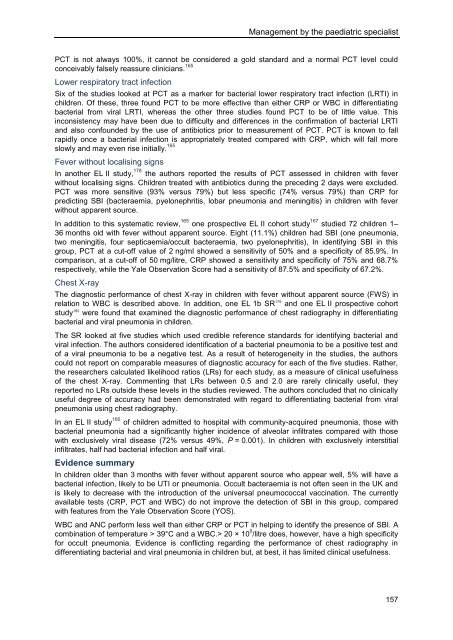A5V4d
A5V4d
A5V4d
Create successful ePaper yourself
Turn your PDF publications into a flip-book with our unique Google optimized e-Paper software.
Management by the paediatric specialist<br />
PCT is not always 100%, it cannot be considered a gold standard and a normal PCT level could<br />
conceivably falsely reassure clinicians. 165<br />
Lower respiratory tract infection<br />
Six of the studies looked at PCT as a marker for bacterial lower respiratory tract infection (LRTI) in<br />
children. Of these, three found PCT to be more effective than either CRP or WBC in differentiating<br />
bacterial from viral LRTI, whereas the other three studies found PCT to be of little value. This<br />
inconsistency may have been due to difficulty and differences in the confirmation of bacterial LRTI<br />
and also confounded by the use of antibiotics prior to measurement of PCT. PCT is known to fall<br />
rapidly once a bacterial infection is appropriately treated compared with CRP, which will fall more<br />
slowly and may even rise initially. 165<br />
Fever without localising signs<br />
In another EL II study, 178 the authors reported the results of PCT assessed in children with fever<br />
without localising signs. Children treated with antibiotics during the preceding 2 days were excluded.<br />
PCT was more sensitive (93% versus 79%) but less specific (74% versus 79%) than CRP for<br />
predicting SBI (bacteraemia, pyelonephritis, lobar pneumonia and meningitis) in children with fever<br />
without apparent source.<br />
In addition to this systematic review, 165 one prospective EL II cohort study 167 studied 72 children 1–<br />
36 months old with fever without apparent source. Eight (11.1%) children had SBI (one pneumonia,<br />
two meningitis, four septicaemia/occult bacteraemia, two pyelonephritis), In identifying SBI in this<br />
group, PCT at a cut-off value of 2 ng/ml showed a sensitivity of 50% and a specificity of 85.9%. In<br />
comparison, at a cut-off of 50 mg/litre, CRP showed a sensitivity and specificity of 75% and 68.7%<br />
respectively, while the Yale Observation Score had a sensitivity of 87.5% and specificity of 67.2%.<br />
Chest X-ray<br />
The diagnostic performance of chest X-ray in children with fever without apparent source (FWS) in<br />
relation to WBC is described above. In addition, one EL 1b SR 179 and one EL II prospective cohort<br />
study 180 were found that examined the diagnostic performance of chest radiography in differentiating<br />
bacterial and viral pneumonia in children.<br />
The SR looked at five studies which used credible reference standards for identifying bacterial and<br />
viral infection. The authors considered identification of a bacterial pneumonia to be a positive test and<br />
of a viral pneumonia to be a negative test. As a result of heterogeneity in the studies, the authors<br />
could not report on comparable measures of diagnostic accuracy for each of the five studies. Rather,<br />
the researchers calculated likelihood ratios (LRs) for each study, as a measure of clinical usefulness<br />
of the chest X-ray. Commenting that LRs between 0.5 and 2.0 are rarely clinically useful, they<br />
reported no LRs outside these levels in the studies reviewed. The authors concluded that no clinically<br />
useful degree of accuracy had been demonstrated with regard to differentiating bacterial from viral<br />
pneumonia using chest radiography.<br />
In an EL II study 180 of children admitted to hospital with community-acquired pneumonia, those with<br />
bacterial pneumonia had a significantly higher incidence of alveolar infiltrates compared with those<br />
with exclusively viral disease (72% versus 49%, P = 0.001). In children with exclusively interstitial<br />
infiltrates, half had bacterial infection and half viral.<br />
Evidence summary<br />
In children older than 3 months with fever without apparent source who appear well, 5% will have a<br />
bacterial infection, likely to be UTI or pneumonia. Occult bacteraemia is not often seen in the UK and<br />
is likely to decrease with the introduction of the universal pneumococcal vaccination. The currently<br />
available tests (CRP, PCT and WBC) do not improve the detection of SBI in this group, compared<br />
with features from the Yale Observation Score (YOS).<br />
WBC and ANC perform less well than either CRP or PCT in helping to identify the presence of SBI. A<br />
combination of temperature > 39°C and a WBC.> 20 × 10 9 /litre does, however, have a high specificity<br />
for occult pneumonia. Evidence is conflicting regarding the performance of chest radiography in<br />
differentiating bacterial and viral pneumonia in children but, at best, it has limited clinical usefulness.<br />
157


